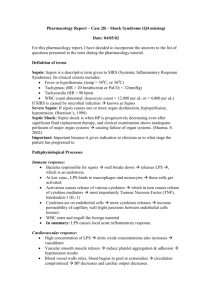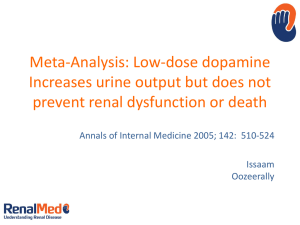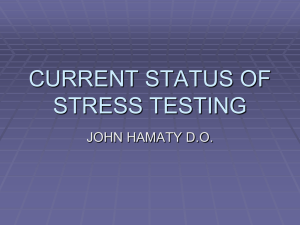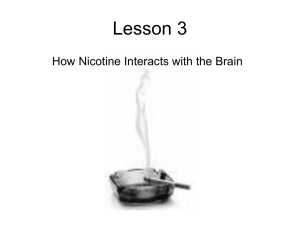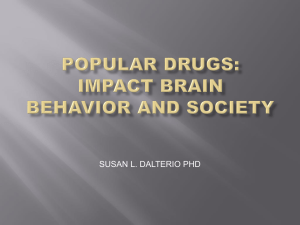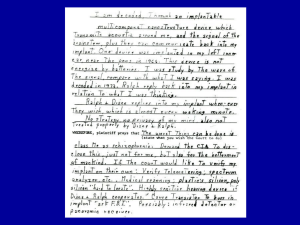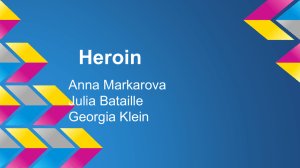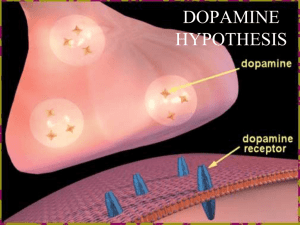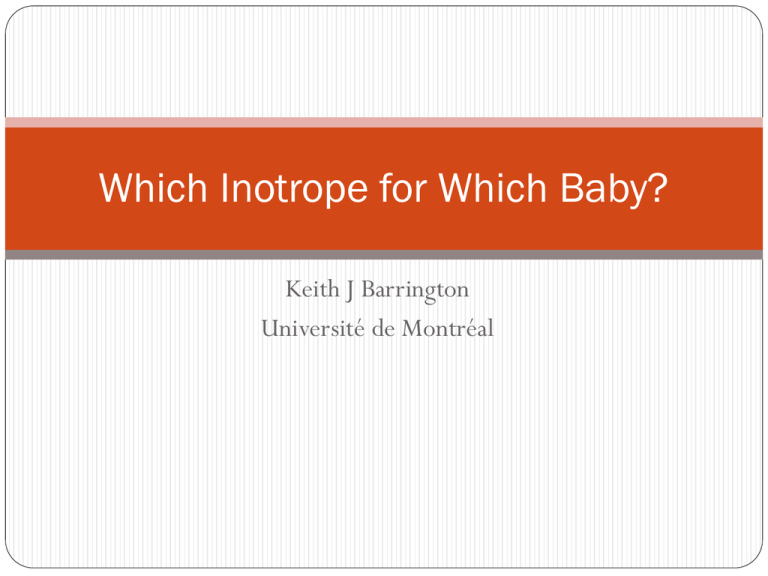
Which Inotrope for Which Baby?
Keith J Barrington
Université de Montréal
B lo o d P re s s u re
Hypotension or shock?
D O 2 /V O 2
What questions to ask
When deciding about cardiovascular support there are 4
questions to ask
1. Does the infant need treatment?
2. What is the current hemodynamic situation?
3. Which agent has a profile of effects that respond to the
current situation?
4. Is there any evidence that this agent will improve outcomes?
How to find the answers
1. Does the infant need treatment?
Closely tied to the answer to question 4.
For example a numerically low blood pressure probably does
not need any intervention unless there are signs of poor
perfusion
But an infant with progressive acidosis and anuria might well
2. What is the current hemodynamic
situation?
History, Clinical examination, special tests
History might be useful for diagnosing Hypovolemic shock and
Septic shock
But we have very little information about the hemodynamics of septic
shock in babies.
Clinical examination including toe temperature, capillary filling,
urine output,
Special tests, lactate, Functional Echocardiography
What does your hemodynamic
evaluation need to tell you?
Blood pressure
Heart rate
’Cardiac Output’
Pulmonary Hypertension?
Renal perfusion
CNS perfusion
Cardiac function
Preload
Afterload
Contractility
When you have this information: want
next?
What agents improve contractility?
What agents affect afterload?
What agents affect preload?
Functional
Neonatal hearts are functionally immature and are operating
at such a relatively high performance that:
There is little contractile reserve.
Frank Starling curve is flatter in newborns.
Newborns normally operate near flat portion of the curve.
Neonatal hearts are intolerant of afterload.
The right ventricle is more markedly affected by increased
afterload, but the left doesn’t do very well either.
Effects of afterload
Catecholamine receptors
The catecholamines stimulate a variety of receptors which are
usually categorized as a1, a2 , b1 , b2 , DA1 and DA2.
Traditionally, dopamine is said to stimulate DA receptors at low
concentrations, b receptors at moderate concentrations, and a
receptors at high concentrations.
In reality:
Dopamine has virtually no effect at the b2 receptor, and very little
at the b1 receptor
Enormous variation in serum concentrations are obtained by the
same administered dose of drug, as much as 100 fold variations
may be seen.
Sympathetic innervation
Cardiac sympathetic innervation is incomplete at birth.
The various adrenoceptors appear at differing periods of
ontogenesis.
The pattern of their appearance is not well defined.
b receptors increase in density in late gestation.
High cardiac output at birth may partly be mediated by the
presence of many functional b receptors.
Further stimulation of these receptors in early life, e.g. with
isoproterenol, does not much increase cardiac function.
a1 receptors may appear prior to the b receptor.
Myocardial adrenoceptors
Dopamine receptors are present in the mature coronary
circulation but not in myocardium.
Frequently stated that dopamine’s inotropic effects are due
to release of endogenous norepinephrine from sympathetic
nerve endings (tyramine-like effect).
Dopamine therefore may have indirect a and b effects on
the myocardium.
Rapid tachyphylaxis
The incomplete innervation of the neonatal heart means
that this effect is of little importance in the newborn.
Newborn hearts are not
small adult Hearts!
Vascular catecholamine receptors
There is much less information regarding the rates of
appearance and maturation of vascular adrenoceptors.
a1 receptors are present in neonatal peripheral circulation
and respond to a1 stimulants such as phenylephrine.
a1 receptors appear to be relatively lacking in the pulmonary
circulation of the lamb.
Vascular b receptors are next to appear.
DA receptors probably largely become active during
postnatal life.
3. Which agent has a profile of effects
that respond to the current situation?
I will restrict myself initially to the catecholamines, as they
are most commonly used
LVO & RVO
Dobutamine
Decreases afterload
Increases contractility
Increases systemic perfusion
Unpredictable effects on blood pressure
Causes tachycardia, which will usually resolve
Effects on Pulmonary artery pressures uncertain
Cardiac Index
(mL/kg.min)
50 mg/kg.min chez les
porcelets (Cheung and
Barrington 1998)
Le débit cardiaque a monté
même à 5 mg/kg.min.
Vasodilatation à 5 mg/kg.min
et plus.
Mean
systemic blood pressure
(mmHg)
La TA a augmenté seulement à
300
280
260
240
220
200
180
160
140
120
100
95
90
85
80
75
70
65
Q
Baseline
Systemic vascular resistance
index (torr/mL/kg.min)
Dobutamine
réponse
5
Q
10
Q
Q
>
20
50
Q
Baseline
5
10
20
50
0.6
0.5
Q
0.4
Q
Q
Q
>
>
0.3
0.2
Baseline
5
10
20
Dobutamine dose (mg/kg.min)
50
Figure 3
The hemodynamic effects of dobutamine infusion in the
chronically instrumented newborn piglet.
Cheung, Po-Yin; MBBS, MRCP; Barrington, Keith; MBChB,
FRCP; Bigam, David; MD, FRCS
Critical Care Medicine. 27(3):558-564, March 1999.
Figure 3 . Effects of dobutamine
infusion at 10 [micro sign]g/kg.min on
heart rate (top panel), cardiac index
(middle panel), and stroke volume
(bottom panel) over 120 mins. Means
and SD are shown. *, p < .05 compared
with 0 min;
© 1999 Lippincott Williams & Wilkins, Inc. Published by Lippincott Williams & Wilkins, Inc.
2
Dobutamine: renal and intestinal
perfusion
D O S E (mg/kg.min)
B aseline
5
10
20
50
S M A Flow index
(m L/m in)
S M A resistance
(m m H g/m L/kg.m in)
R enal artery flow
index (m L/kg.m in)
R enal resistance
(m m H g/m L/kg.m in)
41 (16)
43 (16)
38 (13)
37 (13)
36 (12)
2.39 (1.16)
2.14 (0.91)
2.66 (1.31)
2.63 (1.31)
2.48 (0.93)
8.2 (5.4)
8.0 (4.4)
6.3 (4.4)
8.8 (5.6)
6.7 (5.5)
18.3 (10.5)
16.0 (9.5)
19.5 (12.2)
19.1 (13.3)
21.4 (13.1)
= p<0.05 com pared w ith baseline
(Cheung and Barrington, Cardiovasc Res
1996;31:2)
Prolonged dobutamine infusion
T im e from start
(m in)
B aseline
30
60
120
S M A flow
(m L/kg.m in)
S M A resistance
(m m H g/m L/kg.m in)
R enal artery flow
(m L/kg.m in)
R enal resistance
(m m H g/m L/kg.m in)
40.7 (14.7)
44.4 (19.0)
47.3 (18.3)
57.0 (18.9) ,
2.5 (1.2)
2.4 (1.3)
2.2 (1.4)
1.7 (0.94) ,
10.5 (5.4)
11.2 (6.1)
11.6 (5.5)
13.1 (6.2) ,
13.7 (11.6)
13.7 (11.7)
10.9 (7.7)
9.7 (7.6) ,
= p<0.05 com pared w ith baseline, = p<0.05 com pared w ith 30 m inutes
Dopamine
Increases afterload
Increases blood pressure
Increases pulmonary artery pressure
Often associated with a decrease in systemic perfusion
Dopaminergic effects?
Pituitary suppression
No increase in renal perfusion
Possible increase in Gut perfusion
% change in blood pressure
Jirsch DW, Cheung PY.
Dopaminergic receptor-mediated
effects in the mesenteric
vasculature and renal vasculature
of the chronically instrumented
newborn piglet. Crit Care Med
1996 Oct;24(10):1706-12.
% change in renal artery flow
Pearson RJ, Barrington KJ,
20
10
0
-10
-20
-30
-40
-50
% change in renal vascular resistance
dopamine and
renal perfusion:
40
30
20
10
0
-10
-20
H
H
100
80
60
40
20
0
-20
-40
H
2
4
8
16
32
Dopamine dosage (mg/kg.min)
agoniste sélectif au
récepteur d1.
Chez le nouveau-né il n’y
a pas de dilatation rénale.
La résistance vasculaire
rénale n’est pas affectée
peu importe la dose.
% change in blood pressure
% change in renal artery flow
Fenoldopam est un
% change in renal vascular resistance
Effets d1 agoniste
sélectif
10
0
H
-10
H
H
-20
-30
40
20
0
-20
-40
150
100
50
0
-50
-100
1
5
10
25
50
100
Fenoldopam dosage (mg/kg.min)
dopamine and intestinal perfusion
60
H =p<0.05
Percentage change in SMA flow
50
40
30
H
H
20
10
0
-10
-20
2
4
8
16
Dopamine dose (mg/kg/min)
32
dopamine and intestinal vascular
resistance
Percentage change in mesenteric vascular resistance
40
H =p<0.05
20
0
H
-20
-40
2
4
8
16
Dopamine dose (mg/kg/min)
32
% change in blood pressure
Effets de d1
agoniste sélectif
0
-10
H
-20
H
H
-30
Le fenoldopam a provoqué une
% change in SMA flow
80
% change in SMA resistance
dilatation de la circulation
mésentérique à des concentrations
élevées seulement.
Donc, le récepteur d1 semble être
actif dans la circulation intestinale du
porcelet nouveau-né, mais son
activité est réduite.
10
60
H
H
40
H
H
20
0
-20
-40
40
20
0
-20
-40
H
H
H
H
H
-60
-80
1
5
10
25
50
100
Fenoldopam dosage (mg/kg.min)
Change in left ventricular output (A), mean blood pressure (B), and systemic vascular
resistance (C) after dopamine treatment in groups 1 and 2 neonates.
Zhang J et al. Arch Dis Child Fetal Neonatal Ed
1999;81:F99-F104
Copyright © BMJ Publishing Group Ltd & Royal College of Paediatrics and Child Health. All rights reserved.
Changes in anterior cerebral artery mean blood velocity (A) and blood velocity–time integral
(B), and cerebral vascular resistance index (C) after dopamine treatment in both groups.
Zhang J et al. Arch Dis Child Fetal Neonatal Ed
1999;81:F99-F104
Copyright © BMJ Publishing Group Ltd & Royal College of Paediatrics and Child Health. All rights reserved.
Change in mesenteric artery mean blood velocity (A) and blood velocity–time integral (B) and
mesenteric resistance index (C) after dopamine treatment in both groups: *p <0.05; ** p <
0.01, group 1 vs group 2.
Zhang J et al. Arch Dis Child Fetal Neonatal Ed
1999;81:F99-F104
Copyright © BMJ Publishing Group Ltd & Royal College of Paediatrics and Child Health. All rights reserved.
Epinephrine
Decreases afterload
Increases systemic perfusion
Increases blood pressure
Probably increases PA pressure less than systemic pressure
Norepinephrine
Increases afterload
Increases blood pressure
Effects on systemic perfusion uncertain
Effects on regional perfusion uncertain
Effects on pulmonary artery pressure uncertain in the human
newborn,
but experimental evidence of pulmonary vasodilatation in the
fetus and in the presence of vasoconstriction
Other agents
Milrinone
Vasopressin
Levosimendan
Milrinone
Phosphodiesterase III inhibitors increase intracellular cAMP:
inotropic effects and vasodilatation.
In neonatal models PDE III inhibitors have minimal effects, no
effect, or even negative inotropic effects.
developmental imbalance between class III and class IV Phosphodiesterase in
neonatal sarcoplasmic reticulum.
Negative inotropic effects in neonatal puppies become positive in
1st few days after birth.
The effects on preterm human myocardium are unknown
Age (h)
SVC (mL/kg/min)
Milrinone (n = 42)
Placebo (n = 48)
P value
3‡
7
78 (51, 107)
70 (48, 92)
86 (67, 107)
75 (51, 94)
.2
.8
10
67 (53, 87)
81 (50, 100)
.5
24
88 (73, 101)
93 (72, 121)
.4
3‡
182 (140, 240)
189 (133, 271)
.9
7
177 (147, 258)
187 (140, 240)
.9
10
189 (146, 258)
187 (133, 243)
.4
24
242 (194, 301)
250 (207, 306)
.7
BP (mm Hg)
3‡
31 ± 6
30 ± 3
.4
HR (beats/min)
7
10
24
3‡
7
10
24
28 ± 5
29 ± 4
34 ± 5
149 ± 16
158 ± 15
157 ± 13
153 ± 13
32 ± 6
32 ± 5
36 ± 6
151 ± 17
145 ± 10
141 ± 12
144 ± 14
.001
.004
.2
.6
.001
.001
.003
PDA diameter
3‡
2 ± 0.9
1.9 ± 0.6
.5
(mm)
7
10
24
1.9 ± 0.7
1.9 ± 0.6
1.7 ± 0.8
1.5 ± 0.6
1.4 ± 0.6
0.9 ± 0.7
.001
.001
.001
RVO (mL/kg/min)
Milrinone
clinical trial
Vasopressin effects in adults
Vasopressin in experimental septic
shock
Powerful vasoconstrictor, no inotrope effects
Decreases systemic perfusion
Decreases renal and hepatic blood flow
May increase urine output, by a pressure diuresis
Great caution!!
Levosimendan
Calcium sensitizing agent
Theoretical reasons for thinking that it might have benefit in
the newborn
Animal studies and 2 case reports.
Possibly for the future
Based on these physiologic
considerations
Low BP and low systemic perfusion (with or without
pulmonary hypertension)
Epinephrine
Low BP and maintained perfusion, but signs of end-organ
dysfunction
Norepinephrine or dopamine (probably norepinephrine if
pulmonary hypertension)
Adequate BP but poor cardiac function
Dobutamine
4. Evidence that one agent or another
improves clinically important outcomes
Septic Shock
No evidence
Pulmonary hypertension
No evidence
Cardiomyopathy and other conditions….
Same answer
Full careful evaluation, including evaluation of systemic
flows, followed by application of physiologic and
pharmacologic principles is currently the best we can do.

